Pharmaceutical Glass Vials And Ampoules Market Size and Share
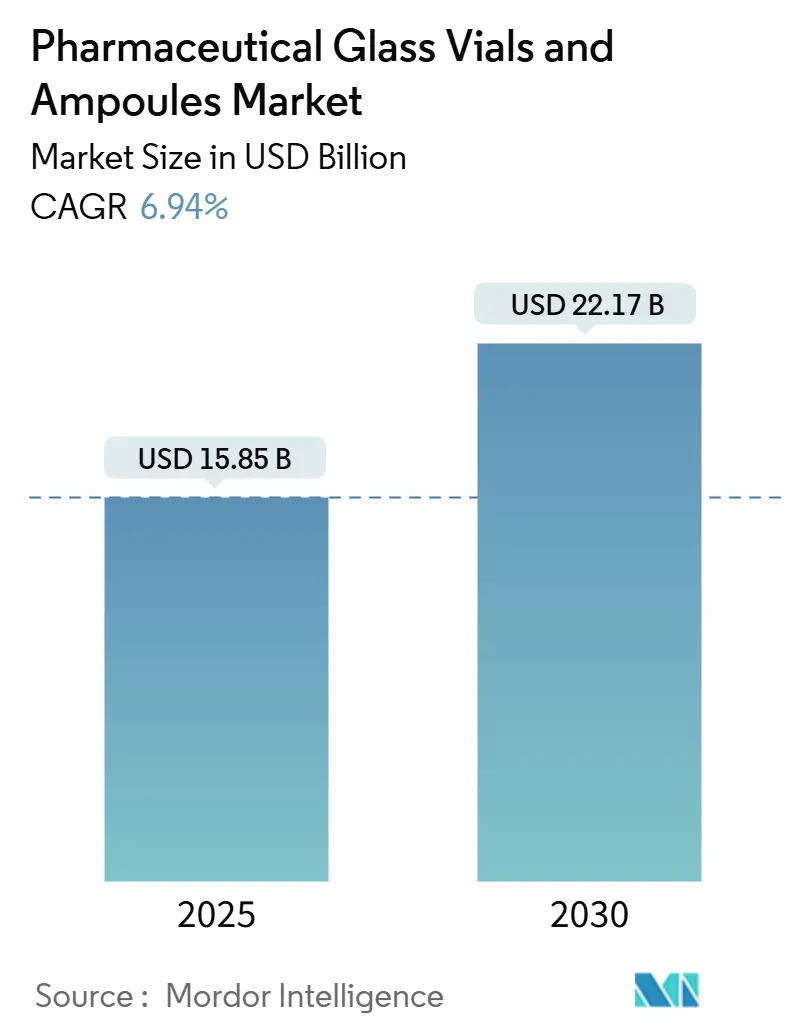
Pharmaceutical Glass Vials And Ampoules Market Analysis by Mordor Intelligence
The pharmaceutical glass vials and ampoules market size stands at USD 15.85 billion in 2025 and is forecast to reach USD 22.17 billion by 2030, advancing at a 6.94% CAGR. Robust fundamentals including expanding biologics pipelines, demanding cold-chain requirements for mRNA therapeutics, and global serialization mandates continue to favor glass over polymer alternatives. Type I borosilicate retains primacy because its chemical inertness and thermal stability safeguard high-value injectables from leachables and breakage. Technology upgrades such as ready-to-use (RTU) sterile platforms lower contamination risk and trim fill-finish cycle times, strengthening supplier pricing power. Regionally, Asia-Pacific registers outsized capital inflows into vial manufacturing, while North America’s stringent FDA standards solidify its dominant share position. Competitive intensity remains moderate, with leaders funneling investment into surface-coating science, hydrogen-fired furnaces, and automated visual inspection to defend margins in an otherwise cost-sensitive environment.
Key Report Takeaways
- By material, Type I borosilicate captured 65.32% of the pharmaceutical glass vials and ampoules market share in 2024, whereas hybrid and surface-coated glass is projected to expand at a 7.54% CAGR through 2030.
- By application, vaccines led with 46.32% revenue share in 2024; biologics and biosimilars are on track to grow at an 8.23% CAGR to 2030.
- By end user, pharmaceutical manufacturers controlled 55.32% of global volume in 2024, while CDMOs and CMOs record the fastest CAGR of 7.84% through 2030..
- By manufacturing technology, tubular glass forming held 63.21% of the pharmaceutical glass vials and ampoules market size in 2024; RTU sterile systems advance at an 8.23% CAGR through 2030.
- By geography, North America commanded 39.43% share of the pharmaceutical glass vials and ampoules market in 2024, yet Asia-Pacific is accelerating at a 9.12% CAGR to 2030.
Global Pharmaceutical Glass Vials And Ampoules Market Trends and Insights
Drivers Impact Analysis
| Driver | (~) % Impact on CAGR Forecast | Geographic Relevance | Impact Timeline |
|---|---|---|---|
| Post-pandemic vaccine pipeline boosts vial demand | +1.2% | Global, with concentration in North America and Europe | Medium term (2-4 years) |
| Biologics shift toward chemically inert borosilicate | +0.8% | Global, led by North America and Europe | Long term (≥ 4 years) |
| Sustainability and recyclability regulations favour glass | +0.6% | Europe and North America, expanding to APAC | Long term (≥ 4 years) |
| RFID-serialisation mandates for colour-coded ampoules | +0.4% | Global, with EU FMD and US DSCSA leading | Medium term (2-4 years) |
| mRNA cold-chain needs ultra-low expansion glass | +0.3% | North America and Europe, selective APAC markets | Short term (≤ 2 years) |
| Source: Mordor Intelligence | |||
Post-pandemic Vaccine Pipeline Boosts Vial Demand
Global vaccine development no longer tapers after seasonal campaigns; instead, multi-pathogen programs targeting RSV, malaria, and combination boosters are expanding. Capacity additions such as SCHOTT’s USD 1.13 billion upgrade elevate small-volume Type I production to meet multi-dose presentation needs. Regulators insist on final-container stability testing from Phase I onward, lifting glass consumption per program by roughly 40%. Pediatric formulations often specify 2 mL and 5 mL vials, accentuating demand for dimensional accuracy and stringent particulate thresholds. These dynamics collectively reinforce a secular uplift in core vial volumes despite intermittent procurement pauses once pandemic stockpiles normalize.
Biologics Shift Toward Chemically Inert Borosilicate
Large-molecule pipelines demand containers that resist alkali leaching and surface reactivity. FDA guidance released in 2024 underscores compatibility testing protocols that implicitly steer developers toward Type I borosilicate. [1]U.S. Food and Drug Administration, “Container Closure Systems for Packaging Human Drugs and Biologics,” fda.govStevanato’s EZ-fill platform reduces extractables below 1 ppm, a threshold attractive to biosimilar launches where process comparability is scrutinized.[2]Stevanato Group, “EZ-fill Technology Platform for Enhanced Fill-Finish Operations,” stevanato.com The financial calculus is direct: a single product recall can erase USD 50 million in finished-goods value, making higher unit-price glass a rational hedge against stability failures. Consequently, borosilicate suppliers preserve premium pricing even while polymer containers nibble away at low-risk, commodity fills.
Sustainability and Recyclability Regulations Favour Glass
The EU Packaging and Packaging Waste Regulation compels pharmaceutical packagers to verify recyclability pathways, elevating glass because it can be recycled indefinitely without quality loss.[3]European Environment Agency, “EU Emissions Trading System Carbon Pricing Trends,” eea.europa.eu Manufacturers such as Gerresheimer pilot hydrogen-powered melting to cut emissions by 30%, aligning with scope-3 reduction targets of major pharma buyers. Carbon pricing north of USD 90 per ton amplifies the disposal cost gap between single-use polymer and recycled glass, tilting procurement policies toward “glass-first” specifications for new molecules. Progressive payers already embed sustainability metrics in tender evaluations, creating a reinforcing loop of regulatory and commercial pressure that aids the material’s long-run share.
RFID-Serialisation Mandates for Colour-Coded Ampoules
Global track-and-trace deadlines under the US DSCSA in 2024 and the ongoing EU FMD have crystallized demand for ampoules whose surfaces reliably retain RFID labels. Glass offers superior adhesion and optical clarity for machine-vision inspection, resulting in 15% lower serialization failure rates than polymer analogues. Oncology and rare-disease drugs often high-priced and cold-chain-sensitive derive particular value from these compliance gains, as a single label loss can trigger lot-level quarantine. The incremental container cost is outweighed by avoided rework and recall expenses, cementing glass ampoules as the default for serialized, color-coded dose formats.
Restraints Impact Analysis
| Restraint | (~) % Impact on CAGR Forecast | Geographic Relevance | Impact Timeline |
|---|---|---|---|
| Polymer vials cannibalising commodity glass share | -0.9% | Global, particularly in cost-sensitive markets | Medium term (2-4 years) |
| Fragility/breakage recalls increase risk-mitigation cost | -0.5% | Global, with higher impact in emerging markets | Short term (≤ 2 years) |
| Sodium-ion leaching in high-pH gene-therapy fills | -0.3% | North America and Europe, selective biologics applications | Long term (≥ 4 years) |
| Energy-intensive furnaces face carbon-pricing pressure | -0.4% | Europe primarily, expanding to other regions | Medium term (2-4 years) |
| Source: Mordor Intelligence | |||
Polymer Vials Cannibalising Commodity Glass Share
Cyclic olefin polymer containers such as West’s Crystal Zenith line secure orders for diagnostic reagents and early-phase biologics, where break-resistance and flexible lead times outrank lifetime compatibility. Unit economics favor polymers by 20-30% once handling losses and secondary packaging are tallied. Although FDA compatibility hurdles deter polymer uptake for commercial therapeutics, high-volume, lower-risk segments remain vulnerable to substitution. Suppliers of standard blown V-ials therefore experience volume compression at the low end, prompting a strategic pivot toward higher-margin, coated or RTU formats.
Fragility/Breakage Recalls Increase Risk-Mitigation Cost
Recurrent recalls tied to glass particulates such as Gilead’s 2024 Veklury withdrawal—raise alarm over latent fracture and delamination risks. Pharmaceutical buyers respond by imposing stricter QC audits, dual-sourcing mandates, and indemnity clauses that elevate procurement costs by up to 12%. Glass producers must invest in vision-inspection AI, hot-end coating optimization, and tighter dimensional tolerances, inflating capex profiles. Smaller regional manufacturers struggle with these cost ramps, foreshadowing consolidation or voluntary exit in markets unable to absorb escalating compliance expenditure.
Segment Analysis
By Material Type : Borosilicate Dominance Faces Hybrid Innovation
Type I borosilicate retained 65.32% of 2024 revenues, underscoring its entrenched regulatory acceptance and vast stability data bank. The pharmaceutical glass vials and ampoules market size attributed to this material outpaces all other substrates because risk-averse drug makers prioritize known performance envelopes when filing new applications. Hybrid and coated variants, however, deliver the fastest 7.54% CAGR as gene-therapy payloads push extractable allowances ever lower. SCHOTT’s Everic series demonstrates how plasma-enhanced surfaces reduce particle generation, a metric increasingly scrutinized under USP <790> guidelines. As litigation costs soar, procurement teams weigh the premium of enhanced glass against the catastrophic downside of biologic batch failures, creating a price-in-elastic niche where quality trumps unit economics. Soda-lime glass–types II and III–survive mostly in legacy, small-molecule injectables and diagnostic reagents, but their share steadily erodes in favor of higher-grade materials. Aluminum-silicate formulations remain niche, reserved for extreme thermal-shock scenarios such as freeze-drying of high-value oncology APIs.
Across a five-year horizon, analysts expect borosilicate to retain a majority stake yet cede incremental share to surface-engineered hybrids designed for high-pH viral vector suspensions. Supplier investments in hydrogen-assisted furnaces and electric melting reduce the carbon intensity gap between material classes, accommodating ESG-driven sourcing mandates. Early-adopter CDMOs are bundling container specification counseling into tech-transfer packages, effectively locking in hybrid glass at the process-validation stage and cementing multiyear demand visibility for premium grades.
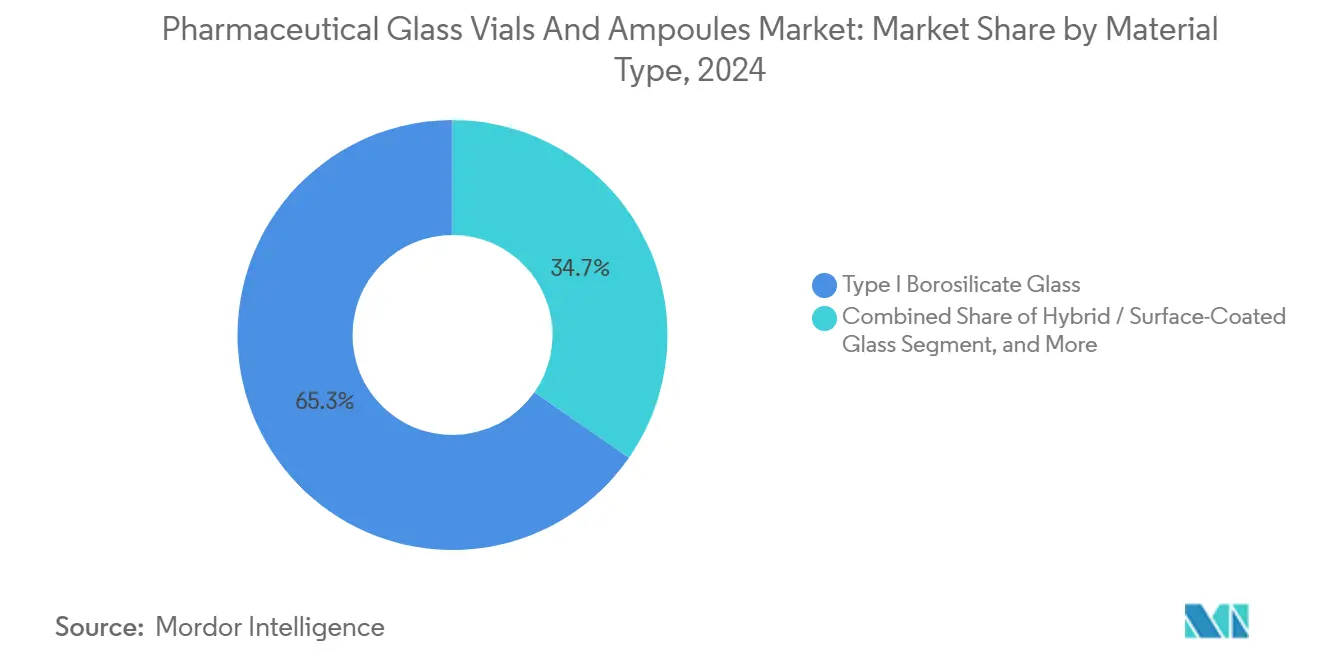
Note: Segment shares of all individual segments available upon report purchase
By Application : Vaccine Volumes Anchor Biologics Upside
Vaccines accounted for 46.32% of 2024 unit demand, undergirded by ongoing pediatric immunization and emerging travel-health indications. Given volume predictability, vial formats have converged on standardized neck dimensions facilitating interchangeable stoppers and automated filling lines. Meanwhile, biologics and biosimilars claim the highest 8.23% growth trajectory, fueled by monoclonal antibody launches post-patent cliff. Here, the pharmaceutical glass vials and ampoules market share shifts toward smaller fill volumes that mitigate wastage for high-price therapies. RTU nest-and-tub formats resonate with biologics lines operating in multiproduct facilities, offering rapid changeovers that boost overall equipment effectiveness.
Small-molecule injectables preserve relevance where drug stability, not packaging, constrains shelf life; however, rising adoption of auto-injectors and prefilled syringes gradually siphons volume from traditional vials. Insulin maintains steady throughput thanks to entrenched cold-chain infrastructure, but continuous-delivery devices are beginning to recalibrate container demand forecasts. Diagnostic reagents, although cost-sensitive, continue to specify glass where solvent polarity or buffered media attack polymer walls, ensuring a residual baseline volume even amid polymer advances.
By End User : CDMO Momentum Complements Pharma Leadership
Pharmaceutical manufacturers controlled 55.32% of 2024 shipments, anchored by vertically integrated supply strategies and multi-year capacity contracts. These buyers emphasize statistical process control and global audit harmonization, channeling business toward suppliers with multi-continental footprints capable of just-in-time deliveries. The pharmaceutical glass vials and ampoules market size allocated to CDMOs is scaling at a 7.84% CAGR as outsourcing normalizes for both innovators and specialty pharma. High-mix, low-volume production typical of personalized medicines aligns neatly with CDMO operating models, propelling demand for RTU nests that eliminate autoclave cycles.
Biotechnology start-ups prefer hybrid glass despite higher cost because grant-funded clinical programs must derisk CMC variability. Academic and research laboratories remain volume-modest yet technically demanding, often specifying nanogram-level particulate thresholds for novel modality testing. Hospitals and clinics, while downstream, influence specifications through pharmacopoeial committees that increasingly cite end-use handling breakage and particulate risk, indirectly steering container selection upstream.
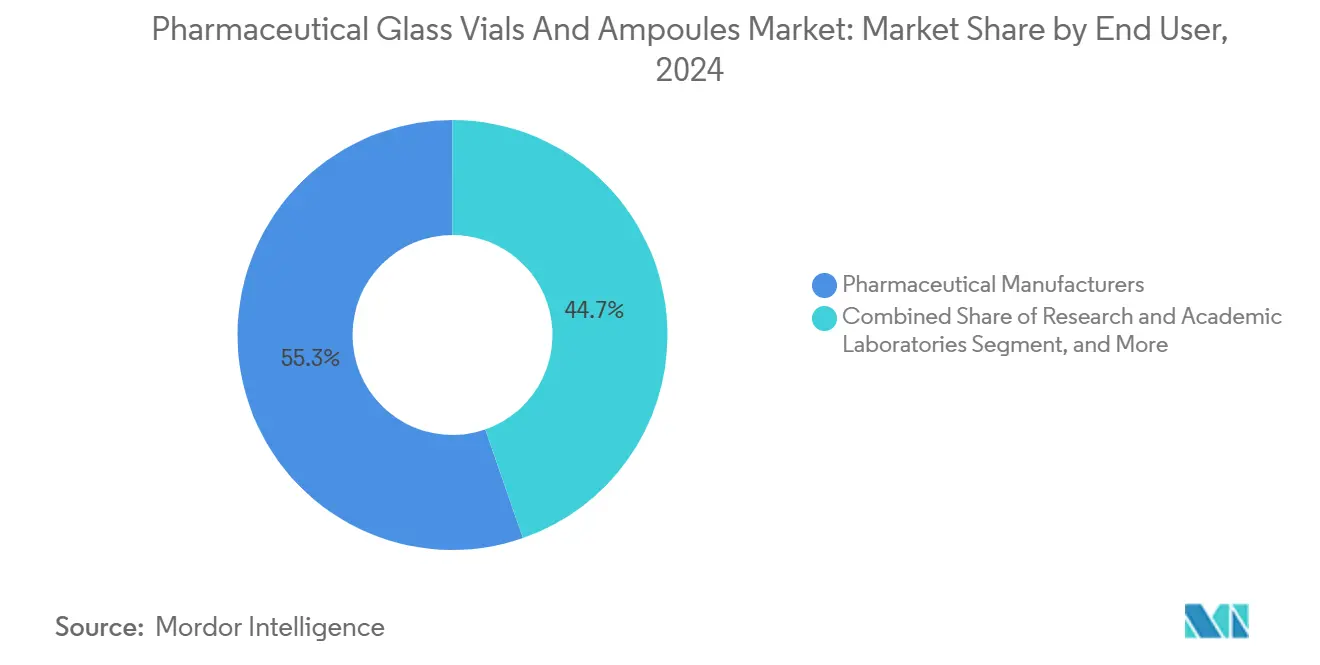
Note: Segment shares of all individual segments available upon report purchase
By Manufacturing Technology : RTU Systems Accelerate Adoption
Tubular glass forming delivered 63.21% of filled-container output in 2024, validating its cost efficiency and precise wall-thickness control. Still, RTU sterile formats demonstrate an 8.23% CAGR because they compress validation timelines and minimize non-sterile handling. Pharmaceutical buyers calculate that each avoided wash-tunnel cycle increases final-yield percentages, justifying premium per-unit fees. The pharmaceutical glass vials and ampoules market size attributed to molded glass remains niche, supporting specialty geometries like dual-chamber designs for lyophilized biologics requiring reconstitution at point of care.
Automation upgrades, including inline stopper presence detection and laser-coding of individual nests, further reduce deviation rates on RTU lines. Suppliers collaborate with elastomer vendors to optimize closure compatibility, evidence that container, closure, and filling technology now co-evolve rather than develop in silos. As regulatory agencies embrace parametric release, RTU adoption gains another tailwind: faster batch disposition and reduced warehouse dwell times.
Geography Analysis
North America retained 39.43% of 2024 revenues, buoyed by expansive biologics capacity, Biologics License Application pipelines, and the FDA’s strict container-closure protocols that privilege Type I borosilicate. Canada’s federal bio-manufacturing initiative adds incremental demand, reinforcing regional supply commitments with multi-year offtake agreements. The pharmaceutical glass vials and ampoules market size in Asia-Pacific, while smaller in absolute terms, grows at a 9.12% CAGR on the back of Chinese GMP enhancements and Indian production-linked incentives that subsidize furnace modernization. Contract packagers in South Korea and Singapore lure global brands with competitively priced RTU offerings that meet ICH standards, trimming lead times into Japan and Australia.
Europe commands robust share underpinned by legacy manufacturers and a strong sustainability framework; yet rising carbon-credit costs pressure margins, nudging procurement to evaluate mixed sourcing models tapping Thai and Indonesian plants for commodity volumes. Latin America benefits from near-shoring strategies by U.S. pharma, particularly in Mexico where USMCA trade provisions smooth customs hurdles for vial supply. The Middle East and Africa remain nascent but strategic, with Gulf Cooperation Council nations funding vaccine fill-finish hubs that stipulate local content thresholds, foreshadowing fresh regional demand for primary containers.
Collectively, geographic diversification mitigates single-region disruption risk, but it forces suppliers to harmonize quality systems across heterogeneous regulatory landscapes. Multisite qualification emerges as a decisive criterion in request-for-proposal scoring, pushing small regional producers to partner or consolidate.
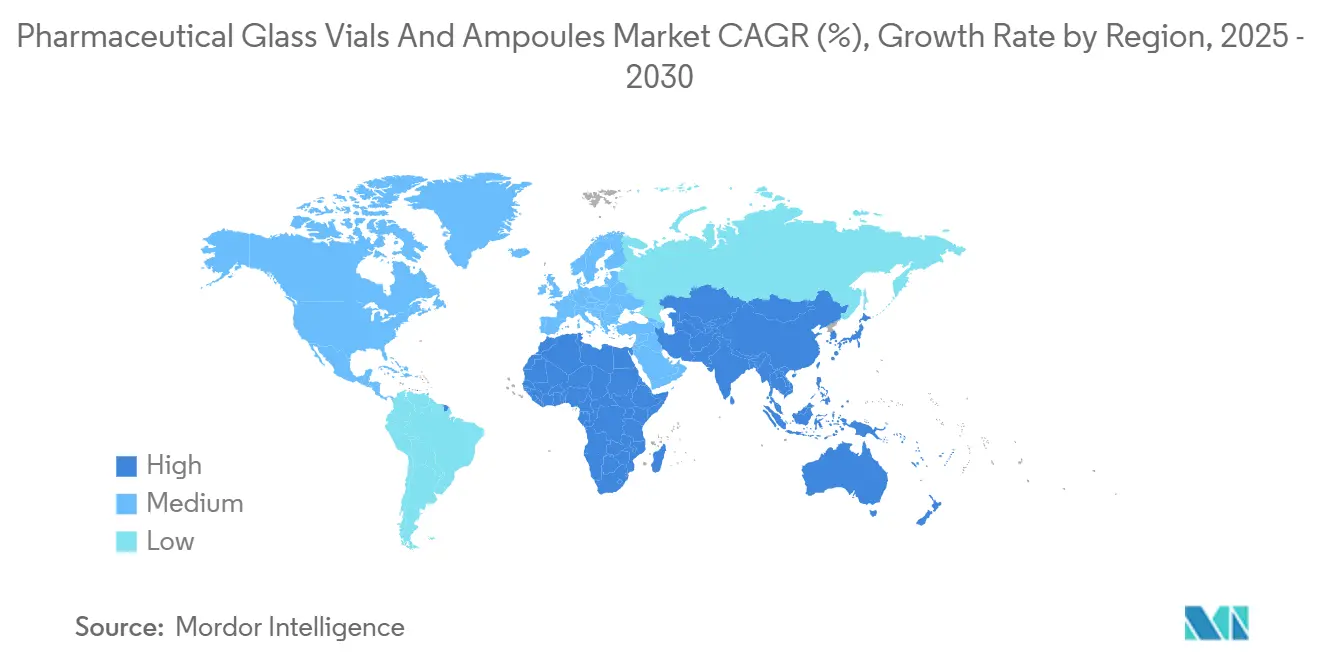
Competitive Landscape
Market structure remains moderately fragmented; the top five producers account for roughly 45% of global turnover, enabling mid-tier and regional firms to compete on proximity, custom design, or specialty coating. SCHOTT, Gerresheimer, and Stevanato Group continue vertical-integration plays, adding RTU nest forming, polymer alternatives, and drug-delivery devices to lock in broader wallet share. Recent capital outlays include Corning’s USD 500 million Valor line expansion aimed at ultra-low-expansion glass for mRNA use cases. Inorganic growth also shapes the field Gerresheimer’s USD 960 million acquisition of Sensile Medical adds connected-device IP that resonates with pharma clients transitioning toward digital therapeutics.
Technology leadership gravitates toward AI-enabled inspection that detects micro-cracks invisible to human operators, cutting defect escapes and bolstering audit scores. Sustainability commitments further delineate competitive tiers; Bormioli’s carbon-neutral facility program appeals to ESG-oriented procurement teams weighing full-life-cycle footprints. Meanwhile, West Pharmaceutical Services hedges with Crystal Zenith polymer vials, positioning itself across material classes. These dynamics suggest a coexistence model rather than a zero-sum race, where polymer and glass each secure differentiated market spaces.
Downstream, CDMOs increasingly influence container choices, bundling supplier evaluation into tech-transfer agreements. Suppliers able to embed on-site technical teams and offer rapid-response metallurgy labs win renewals, while those slow to meet revised particulate or extractable targets lose share to nimbler peers. The balance between consolidation benefits and antitrust scrutiny remains delicate, but cumulative capex needs for decarbonization could accelerate partnership activity.
Pharmaceutical Glass Vials And Ampoules Industry Leaders
-
Gerresheimer AG
-
Nipro Corporation
-
SGD S.A. (SGD Pharma)
-
SCHOTT AG
-
Stevanato Group S.p.A.
- *Disclaimer: Major Players sorted in no particular order
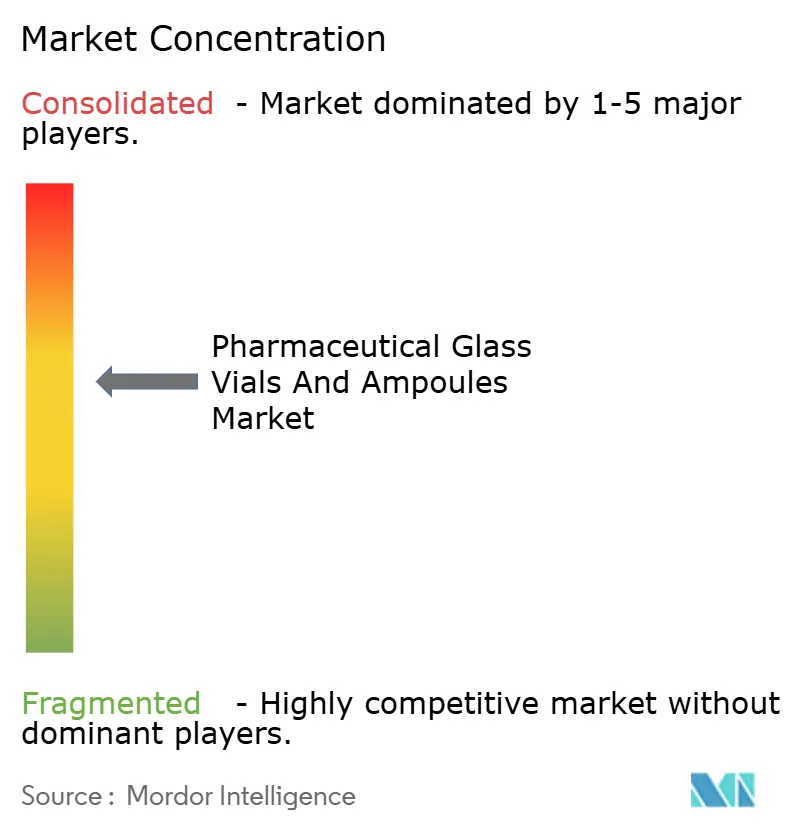
Recent Industry Developments
- January 2025: SCHOTT completed its USD 1.2 billion global capacity expansion, adding 40% output across Germany, India, and Brazil.
- December 2024: Nipro Corporation launched D2F vial technology with Stevanato, integrating EZ-fill nests for biotech fills.
- November 2024: Gerresheimer bought Sensile Medical’s drug-delivery portfolio for EUR 850 million (USD 960 million).
- October 2024: Corning announced a USD 500 million Valor glass expansion in New York targeting mRNA demand.
Global Pharmaceutical Glass Vials And Ampoules Market Report Scope
A vial is a small multi-dose container that can hold liquid drugs, serums, and other pharmaceutical compounds. It is typically made of glass and may or may not be sealed. A vial is the form of a container that possesses a screw-on cap or a rubber plug. In some cases, the top of the vial includes a dropper to estimate the liquid to retrieve. A vial has a flat base so it can rest on a flat surface. Closure systems are of different types; a screw cap is used for glass vials. For lip vials, cork or plastic stoppers, whereas a rubber stopper and a metal cap are usually utilized for crimp vials. An ampoule is a tiny single-dosage vial with a sealed neck. Ampoules cannot be reused, and once the closed neck is snapped off to access the pharmacy drug or any other stored liquid or solid, it is thrown away. However, once opened, the content can be stored in a sealed sterile vial or slim pins.
The pharmaceutical glass vial and ampoules market is segmented into application (vaccines and other application types [insulin, biopharma, others]), geography (North America [United States, Canada], Europe [Germany, United Kingdom, France, Italy, Spain, Rest of Europe], Asia Pacific [China, Japan, India, South Korea, Rest of Asia Pacific], rest of the World). The report offers market forecasts and size in value (USD) for all the above segments.
| Type I Borosilicate Glass |
| Type II/III Soda-Lime Glass |
| Aluminum-Silicate Glass |
| Hybrid / Surface-Coated Glass |
| Vaccines |
| Insulin |
| Biologics and Biosimilars |
| Small-Molecule Injectables |
| Diagnostic Reagents |
| Pharmaceutical Manufacturers |
| Biotechnology Companies |
| CDMOs / CMOs |
| Research and Academic Laboratories |
| Hospitals and Clinics |
| Tubular Glass Forming |
| Moulded Glass Forming |
| Ready-to-Use (RTU) Sterile |
| North America | United States | |
| Canada | ||
| Mexico | ||
| South America | Brazil | |
| Argentina | ||
| Chile | ||
| Rest of South America | ||
| Europe | Germany | |
| United Kingdom | ||
| France | ||
| Italy | ||
| Spain | ||
| Rest of Europe | ||
| Asia-Pacific | China | |
| Japan | ||
| India | ||
| South Korea | ||
| Australia | ||
| Rest of Asia-Pacific | ||
| Middle East and Africa | Middle East | Saudi Arabia |
| United Arab Emirates | ||
| Turkey | ||
| Rest of Middle East | ||
| Africa | South Africa | |
| Nigeria | ||
| Kenya | ||
| Rest of Africa | ||
| By Material Type | Type I Borosilicate Glass | ||
| Type II/III Soda-Lime Glass | |||
| Aluminum-Silicate Glass | |||
| Hybrid / Surface-Coated Glass | |||
| By Application | Vaccines | ||
| Insulin | |||
| Biologics and Biosimilars | |||
| Small-Molecule Injectables | |||
| Diagnostic Reagents | |||
| By End User | Pharmaceutical Manufacturers | ||
| Biotechnology Companies | |||
| CDMOs / CMOs | |||
| Research and Academic Laboratories | |||
| Hospitals and Clinics | |||
| By Manufacturing Technology | Tubular Glass Forming | ||
| Moulded Glass Forming | |||
| Ready-to-Use (RTU) Sterile | |||
| By Geography | North America | United States | |
| Canada | |||
| Mexico | |||
| South America | Brazil | ||
| Argentina | |||
| Chile | |||
| Rest of South America | |||
| Europe | Germany | ||
| United Kingdom | |||
| France | |||
| Italy | |||
| Spain | |||
| Rest of Europe | |||
| Asia-Pacific | China | ||
| Japan | |||
| India | |||
| South Korea | |||
| Australia | |||
| Rest of Asia-Pacific | |||
| Middle East and Africa | Middle East | Saudi Arabia | |
| United Arab Emirates | |||
| Turkey | |||
| Rest of Middle East | |||
| Africa | South Africa | ||
| Nigeria | |||
| Kenya | |||
| Rest of Africa | |||
Key Questions Answered in the Report
How large will global demand for pharmaceutical glass vials and ampoules be by 2030?
The market is forecast to reach USD 22.17 billion by 2030, representing a 6.94% CAGR from 2025 levels.
Which region records the fastest growth in vial and ampoule consumption?
Asia-Pacific advances at a 9.12% CAGR, spurred by new manufacturing investments and quality-driven GMP upgrades.
Why do biologics prefer borosilicate over polymer containers?
Type I borosilicate minimizes alkali leaching, preserves protein integrity, and aligns with FDA compatibility guidance, reducing recall risk.
What technology trend is reshaping fill-finish operations?
Ready-to-use sterile nests streamline changeovers and lower contamination risk, growing at an 8.23% CAGR through 2030.
How are sustainability policies influencing material selection?
EU circular-economy rules and carbon pricing strengthen glass’s appeal because it offers infinite recyclability and falling furnace emission profiles.
Page last updated on:



